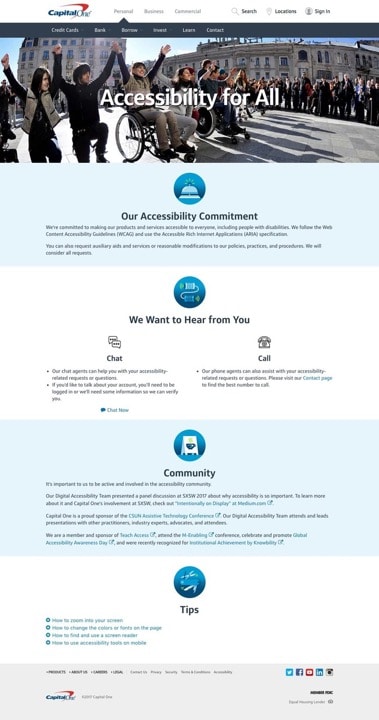Why is a Web Accessibility Policy Crucial to Preventing Lawsuits?
What Does Web Accessibility Mean to the Disabled?
Most of us are familiar with how Accessibility applies to physical business places. However, little thought has been given to how Accessibility applies to the Internet. Accessibility on the World Wide Web demands that we break down barriers and open a clear path for everyone.
This means that web pages must be designed so that those with Visual, Hearing, Motor and Cognitive disabilities have an equal opportunity to navigate and access every web page.
A Published Web Accessibility Statement is Your First Line of Defense
Web Accessibility matters and it is very important to your websites success. It’s so important that your first step toward web accessibility and litigation avoidance is to publish a Web Accessibility Statement on your website. How you do this can dramatically influence your risk.
Your Accessibility statement, linked from the footer of every page speaks to two audiences. It addresses the legal trolls looking for easy money, and legitimately, those with disabilities.
To the potential plaintiff firm trolling for lawsuits, a Web Accessibility Statement placed prominently in the footer serves as a flag to say “we’re on this, move along”. There is so much ripe low hanging fruit, that most trolls will simply skip to the next website on the list.
For the people that count, your disabled visitors, you want to communicate your intent. You need to put everyone on notice that you are committed to web accessibility. You also need to show others how to reach you so that you can help solve their accessibility problems.
It’s important to note that almost 98% of 1,000,000 websites failed when tested for web accessibility.
What Does a Good Web Accessibility Statement Look Like?
Let’s look at a great example of what a good web accessibility statement looks like. One that I like is Capital One’s accessibility commitment statement. Capital One follows the K.I.S.S Principle. Their statement is very simple. Too many of these statements, get into the nitty gritty of spec versions, testing tools used, frequency of auditing, and such.
Don’t overthink or provide more information than is absolutely have to. Providing too much information might increase your exposure.
Capital One starts by saying that they’re committed to following WCAG and ARIA specifications. PERIOD.
They don’t even mention what version or level. They are not specific about their actions. Then, they tell how to get in touch with them.
Finally, they show off their goodwill toward people with disabilities, their actions speak louder than words. They keep it SIMPLE.

In Capital One’s case, they have already been through a full audit and remediation process. That is likely not your situation, else you wouldn’t be reading this.
If you are at the front-end of this process and your site has not been fully audited and remediated, then to start you’re going to want to instead express your intent…. “we are in the process of…. our goal is to…”
I recommend simply making sure you’ve included two things. First, mention the goals you’re striving for and how to reach you for assistance. Secondly, if you engage with the disability community and have accolades to show, that’s great to share.
How Your Actions Can Reduce Your Exposure to Lawsuits
#1 Announce Your Intent and Commitment to Accessibility
Don’t be shy, tell everyone how you are committed to making your content accessible.
- Tell everyone that you are trying to make your website accessible to all visitors. Even if it’s not there yet.
- Profess to everyone that your goal is to provide universal access to your website by following WCAG 2.0 AA guidelines. But this is a work in progress.
- Its ok to publish this before you reach conformity. That said, it might be good to first do a thorough audit (software + manual + assistive technogy testing) and at least check off some of the basic items before publishing. It depends on your brand’s nature and audience.
# 2 Provide a Clear Path For Communication
Its important to enable a person with a complaint or need of assistance to contact you.
- Ensure that a Phone number is prominently displayed. It’s a bonus if it’s toll free and manned 24-7.
- Provide a chat service that is accessible.
- Include a contact form that is accessible.
- Give visitors an email address they can use to receive assistance.
Today its through this path that any legitimate claim about accessibility will likely begin. It’s important that this path be monitored and responded to carefully. Your customer service reps on the receiving end, should have a script and document every interaction. Better yet, use a unique number, email, chat, form that directs to a trained manager.
About the use of an 800 number. In the Dominos case from 2017 the 9th circuit judge in California did accept the argument that providing a toll-free number manned 24 hours did satisfy the spirit of the law. Your 800 number needs to be manned by a qualified person who is qualified to assist disabled users.
This decision is under appeal, and this is by no means a complete solution. However, its not a bad idea and would serve as a legitimate stop-gap measure while remediating your website.
#3 Your Web Accessibility Statements Location Matters
Visitors must be able to find your Web Accessibility statement. Your statements visibility is key. The web accessibility best practice is to include it in the footer of every page, along with your privacy policy.
My personal choice is to give all regulatory statements a prominent position in the header of each page on all my websites. I want visitors comfortable that I do everything I can to be compliant with laws and regulations.
Understanding the Accessibility Issue Offers Hope
A Web Accessibility Policy Statement can provide a first line of defense, protecting you from the legal wolves looking for easy prey. Don’t ignore this advice. Your Accessibility Statement can be very basic in it’s content and nature. Your statement needs to spell out your policy but does not have to be explicit in it’s composition and wording.




